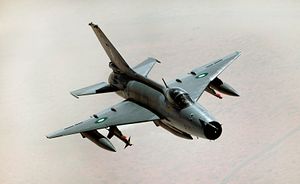China and Pakistan concluded the three-week-long Shaheen-III air exercise on Wednesday. The exercise was the third installment of the Shaheen (Falcon) series of bilateral exercises between the two countries’ air forces, according to Defense News. The exercise is intended to boost cooperation between China and Pakistan and is a source of valuable experience for pilots on both sides. The exercise is “multi-dimensional” and involves operations in “near real [scenarios].”
“A contingent of People’s Liberation Army Air Force (PLAAF), comprises combat pilots, air defence controllers and technical ground crew besides a Pakistan Air force (PAF) contingent are participating in the exercises [sic],” noted Air commodore Tariq Mehmood of the Pakistan Air Force. The PLAAF used its Chengdu J-10 and J-7 combat aircraft while the PAF used its JF-17 Thunder, Mirage, and F7 PG fighters. “The Air Exercises between the two professional Air Forces would not only cement the already existing friendly bonds but would also give an opportunity to learn from each other’s combat experience,” said one PAF spokesperson during the exercises. Shaheen-III is the first exercise in the series to involve the PAF’s JF-17 Thunder.
China sent a six-member PLAAF delegation led by Major General Zhan Houshun to the closing ceremony of the exercise. General Zhan commands the Chengdu Regional Air Force Command and was a coordinating officer for the exercise. According to a report by Pak Tribune, General Zhan lauded the PAF’s training and combat efficiency during the closing ceremony:
PAF has conducted joint exercises with foreign air forces for a long time, obtained great achievements, demonstrated first rate training level and combat efficiency and gained rich experiences that are worth to learn and draw lessons from. We are deeply impressed by PAF’s aggressive combat style and brave fighting spirit and greatly moved by the ‘train as you fight’ training principle and streamlined efficient training approach.
We admire your superb and all round flying skill and outstanding tactical expertise. We have learnt a lot from you which will bring a whole new inspiration to the innovation and development of PLAAF’s military training”. He further said, “I am sure that the closure of joint training is not an end but a new starting point which will deepen, broaden and promote the friendship, exchanges and cooperation between China and Pakistan, the two armed forces and specially the two Air Forces.
The Shaheen series of exercises began in 2011 and was originally designed to allow the air forces of China and Pakistan to cooperate more effectively. Shaheen-I took place in 2011 in Pakistan and Shaheen-II took place in 2013 in China. More broadly, the exercises are designed to cement military-to-military ties between the two countries which often describe their overall relationship as “all-weather” partners. Pakistan and China have generally been rather discrete about the types of maneuvers and aircraft involved in the exercises. Although Pakistan’s media widely reported the aircraft that participated in Shaheen-III, The Diplomat was not able to verify the location of the exercises in Pakistan. Notably, it appears that Pakistan did not deploy its U.S.-built F-16s in its exercise with the PLAAF — likely a move designed to keep the United States from reacting negatively to the exercises.
Although China and Pakistan have framed their recent security cooperation in terms of counter-terrorism, air exercises are generally provocative given that air assets, especially fighters, are seldom deployed against small terror outfits that often use sub-conventional guerrilla tactics. The Shaheen series of exercises have thus received considerable attention in New Delhi and Washington. Last year’s Shaheen-II exercise took place in China’s restive Xinjiang province, the site of an ever-growing struggle between Uyghur separatists and the Chinese government.

































